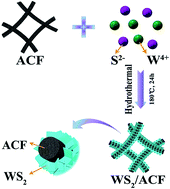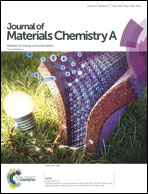Immobilization of tungsten disulfide nanosheets on active carbon fibers as electrode materials for high performance quasi-solid-state asymmetric supercapacitors†
Abstract
The design and fabrication of electrode materials with multidimensional and multifunctional structures have been the key challenge for high-performance asymmetric supercapacitors. Herein, a novel tungsten disulfide/active carbon fiber nanocomposite was synthesized through electrospinning, one-pot carbonization, activation, and a subsequent hydrothermal method. An active carbon fiber with a diameter of about 300 nm is uniformly coated with tungsten disulfide nanosheets with a thickness of 15 nm. Such a nanocomposite exhibits a high capacitance of 600 F g−1 (3108 F cm−3) at 1 A g−1 in 1 mol L−1 KOH. Moreover, the as-fabricated quasi-solid-state asymmetric supercapacitor achieves an appreciable capacitance up to 237.7 F g−1 (514.1 F cm−3) at 1 A g−1 in polyvinyl alcohol/potassium hydroxide gel electrolyte. The excellent electrochemical performance is attributed to the synergetic effects between the thin tungsten disulfide nanosheets with a higher number of active sites and the active carbon fiber with high conductivity. Therefore, it is believed that this novel nanocomposite may shed some light on future electrode design for asymmetric supercapacitors.



 Please wait while we load your content...
Please wait while we load your content...